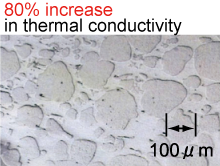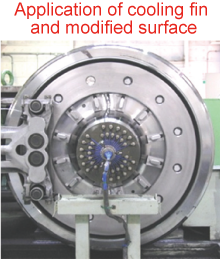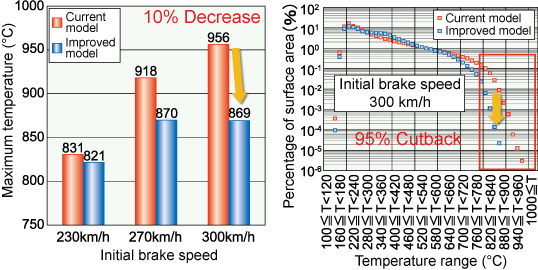2. Method to reduce brake disc surface temperature
- A method was developed to reduce the temperature on brake disc surfaces based on modification of the brake disc surface and fitting of a cooling fin.
- Confirmation was obtained of a reduction in brake disc surface temperature of approximately 10% (90℃).
Higher running speeds and harder braking on high speed railway vehicles such as SHINKANSEN, will lead to an inexorable increase in disc temperatures, which raises the concern of thermal cracking. For this reason, research was carried out to design a system to lower the disc surface temperature. Validation of the cooling effect was achieved by trials on an actual disc on a dynamo test stand.
The disc surface was modified by special welding (Fig 1). Thermal conductivity of the disc was raised by approximately 80% relative to that of its forged steel as base metal. Application of a cooling fin during thermo-hydrodynamic simulation to create surface flow turbulence increased the heat transfer coefficient by about 40% (Fig 2).
An actual brake disc was fitted with the abovementioned proposed solutions (Fig 3) and emergency braking on a test rig was applied at a running speed of 300 km/h. The result of this trial demonstrated that the disc surface temperature was lowered by approximately 10% (of which 83% attributable to the disc surface modification and 17% to the cooling fin). Furthermore, it was confirmed that red heat spots over 800℃ were cutback by approximately 95% (Fig4).
 Fig. 1 Cross section of modified surface
Fig. 1 Cross section of modified surface Fig. 2 Result of thermo-hydrodynamic simulation (flow lines)
Fig. 2 Result of thermo-hydrodynamic simulation (flow lines)
 Fig. 3 Disc with added improvements
Fig. 3 Disc with added improvements Fig. 4 Surface temperature and temperature distribution (Emergency braking)
Fig. 4 Surface temperature and temperature distribution (Emergency braking)